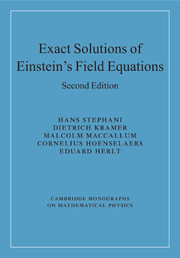Book contents
- Frontmatter
- Contents
- Preface
- List of tables
- Notation
- 1 Introduction
- Part I General methods
- Part II Solutions with groups of motions
- 11 Classification of solutions with isometries or homotheties
- 12 Homogeneous space-times
- 13 Hypersurface-homogeneous space-times
- 14 Spatially-homogeneous perfect fluid cosmologies
- 15 Groups G3 on non-null orbits V2. Spherical and plane symmetry
- 16 Spherically-symmetric perfect fluid solutions
- 17 Groups G2 and G1 on non-null orbits
- 18 Stationary gravitational fields
- 19 Stationary axisymmetric fields: basic concepts and field equations
- 20 Stationary axisymmetric vacuum solutions
- 21 Non-empty stationary axisymmetric solutions
- 22 Groups G2I on spacelike orbits: cylindrical symmetry
- 23 Inhomogeneous perfect fluid solutions with symmetry
- 24 Groups on null orbits. Plane waves
- 25 Collision of plane waves
- Part III Algebraically special solutions
- Part IV Special methods
- Part V Tables
- References
- Index
24 - Groups on null orbits. Plane waves
from Part II - Solutions with groups of motions
Published online by Cambridge University Press: 10 November 2009
- Frontmatter
- Contents
- Preface
- List of tables
- Notation
- 1 Introduction
- Part I General methods
- Part II Solutions with groups of motions
- 11 Classification of solutions with isometries or homotheties
- 12 Homogeneous space-times
- 13 Hypersurface-homogeneous space-times
- 14 Spatially-homogeneous perfect fluid cosmologies
- 15 Groups G3 on non-null orbits V2. Spherical and plane symmetry
- 16 Spherically-symmetric perfect fluid solutions
- 17 Groups G2 and G1 on non-null orbits
- 18 Stationary gravitational fields
- 19 Stationary axisymmetric fields: basic concepts and field equations
- 20 Stationary axisymmetric vacuum solutions
- 21 Non-empty stationary axisymmetric solutions
- 22 Groups G2I on spacelike orbits: cylindrical symmetry
- 23 Inhomogeneous perfect fluid solutions with symmetry
- 24 Groups on null orbits. Plane waves
- 25 Collision of plane waves
- Part III Algebraically special solutions
- Part IV Special methods
- Part V Tables
- References
- Index
Summary
Introduction
In classifying space-times according to the group orbits in Chapters 11–22, we postponed the case of null orbits; they will be the subject of this chapter. All space-times considered here satisfy the condition Rabkakb = 0.
A null surface Nm is geometrically characterized by the existence of a unique null direction k tangent to Nm at any point of Nm. The null congruence k is restricted by the existence of a group of motions acting transitively in Nm.
The groups Gr, r ≥ 4, on N3 have at least one subgroup G3 (Theorems 8.5, 8.6 and Petrov (1966), p.179), which may act on N3, N2 or S2. (A G4 on N3 cannot contain G3 on T2 since the N3 contains no T2.) For G3 on S2, one obtains special cases of the metric (15.4) admitting either a group G3 on N3 or a null Killing vector (see Barnes (1973a)). For G3 on N2, the metric also admits a null Killing vector (Petrov 1966, p.154, Barnes 1979).
Thus we need only consider here the groups G3 on N3 (§24.2), G2 on N2 (§24.3), and G1 on N1 (§24.4). As we study the case of null Killing vectors (G1 on N1) separately, we can also restrict ourselves to groups G3 on N3 and G2 on N2 generated by non-null Killing vectors. It will be shown that in these cases, independent of the group structure, there is always a non-expanding, non-twisting and shearfree null congruence k.
- Type
- Chapter
- Information
- Exact Solutions of Einstein's Field Equations , pp. 375 - 386Publisher: Cambridge University PressPrint publication year: 2003



